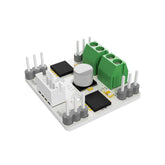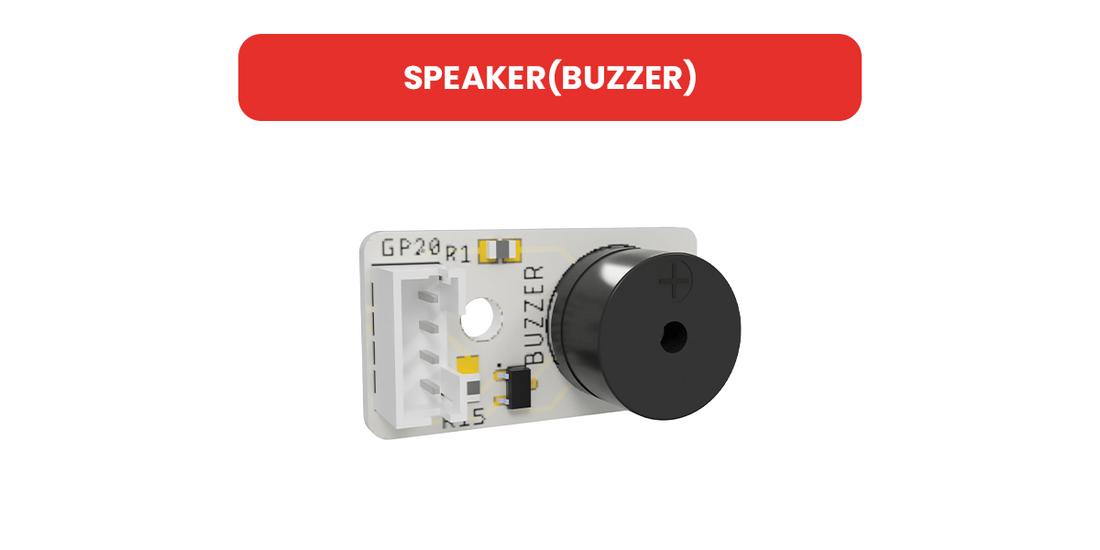Buzzer meaning electronic component that generates sound through the transmission of electrical signals. Its primary function is to provide an audible alert or notification and typically operates within a voltage range of 5V to 12V. There are various types of these modules that differ in their sound generation mechanisms, operating principles, and applications.
Table of Contents
How it Works?
Here's how a typical buzzer works:
-
Power Source: The buzzer requires a power source to operate, typically a direct current (DC) supply.
-
Electromagnetic Coil: Inside the buzzer, there is an electromagnetic coil. When electricity is supplied, the coil becomes magnetized.
-
Metal Diaphragm: Adjacent to the coil, there's a metal diaphragm. This diaphragm is usually made from a ferromagnetic material, which means it's attracted to magnets.
-
Operation Mechanism: When the current flows through the coil, it creates a magnetic field. This magnetic field causes the metal diaphragm to be attracted towards the coil, moving away from its original position.
-
Sound Production: As the diaphragm moves, it compresses and rarefies the air in front of it, creating sound waves. The rapid movement back and forth of the diaphragm produces the buzzing sound we hear.
-
Oscillation: In some buzzers, particularly piezoelectric types, the electric current causes the piezoelectric material (usually a ceramic disc) to bend back and forth. This bending motion creates the sound. The frequency of the current determines the frequency of the sound, and thus its pitch.
-
Volume Control: The volume of the sound can often be controlled by the amount of current supplied to the buzzer. Higher currents produce a louder sound.
Here's a Fun Game to Understand How the Buzzer Works
Buzzer Circuit Diagram

Buzzer Types
- Passive Buzzer: This type of module generates sound through the vibration of a rotating magnetic field within a coil. It requires an external driver circuit and does not produce sound directly.
- Active Buzzer: They have an integrated driver circuit and can operate directly with a sound signal. They are often more user-friendly due to the built-in driver circuit.
- Piezo Buzzer:They produce sound by applying voltage changes to a piezoelectric crystal. They are widely used due to their small size and low power consumption.
- Electromechanical Buzzer: They produce sound using the magnetic field of an electromagnet instead of the vibration of a coil. They can produce larger and more powerful sounds.
- Sirens:Sirens are a specialized type of it used in emergency or fire alarm systems. They can generate very high sound levels and are powerful enough to be heard from a distance.
These types are selected based on diverse application requirements, with sound level, power consumption, size, and other factors serving as crucial criteria that influence the buzzer type chosen.
Buzzer Application Areas
- Alarm Systems: They can be utilized to provide audible alarms in burglar alarm systems or fire alarm systems.
- Clock and Timer Alarms: A clock or timer project created with Arduino or Raspberry Pi can incorporate it to sound an alarm at a specific time.
- Music and Melody Playback: Their sounds can be utilized for simple music and melody playback projects, with the ability to program specific notes or music.
- Automation and Control Systems:They can be integrated into automation projects or to indicate when specific events occur. For instance, they can be utilized to provide an audible alert when a door is opened.
- Education and Learning Projects:They are exceptional components for individuals seeking to learn fundamental electronics and coding concepts. They can aid students in comprehending topics such as basic music theory and frequency control.

FAQ
Can a buzzer play music?
Yes, a buzzer can play simple music. However, the sound quality and range are limited compared to dedicated speakers. Buzzers can generate different tones, which can be arranged to play melodies.
Is doorbell a buzzer?
Yes, a doorbell is a type of buzzer specifically designed to signal the presence of a visitor at a door.
What is the difference between intercom and buzzer?
An intercom is a communication system allowing two-way conversation, often used in buildings for speaking between rooms or with visitors at the entrance. A buzzer, on the other hand, is a simple signaling device that makes a buzzing sound, commonly used for alerts or as a doorbell. The key difference is that an intercom facilitates voice communication, while a buzzer only produces a sound signal.
Is a buzzer a sensor?
No, a buzzer is not a sensor. It is an output device used to make a sound or tone. Sensors are input devices that detect changes in the environment, like temperature or light, and convert them into electrical signals. Instead, receives electrical signals to generate sound.
Buzzer devices quietly blend into the fabric of our daily routines, their unassuming presence guiding us through the symphony of modern life. From the gentle morning wake-up call to the subtle reminders throughout the day, these unobtrusive companions play a vital role in keeping us organized and on track. Whether it’s in industrial settings, home electronics, or even in the excitement of a game show, the unmistakable sound they emit unites functionality and fun. Amidst the hustle and bustle, it’s the subtle buzz that underscores their significance, reminding us of their simplicity and efficiency.





